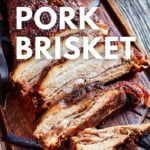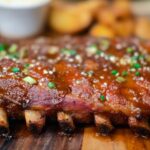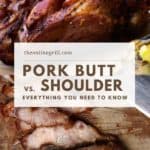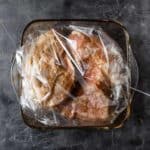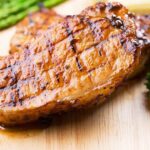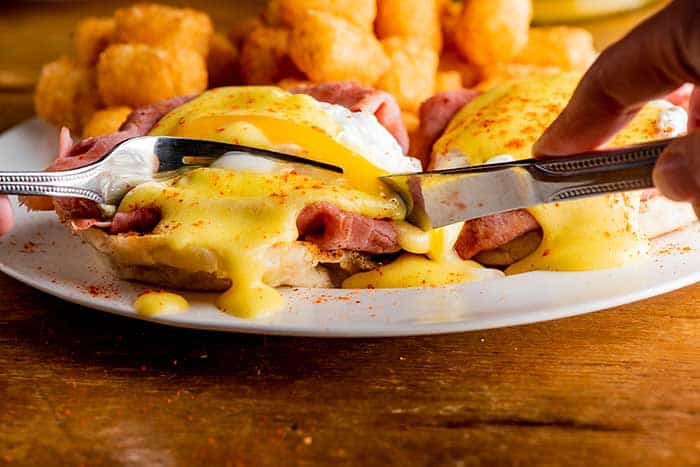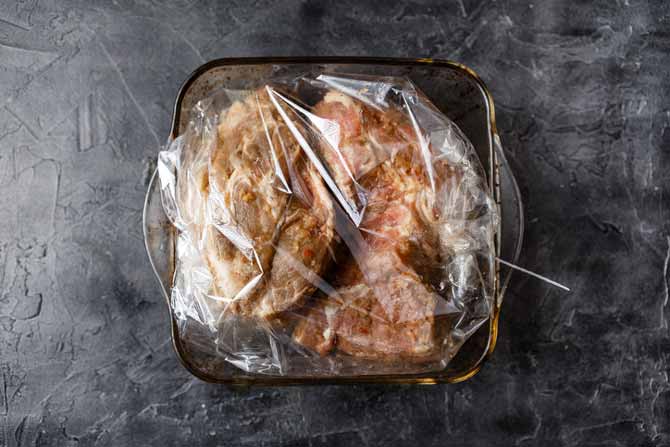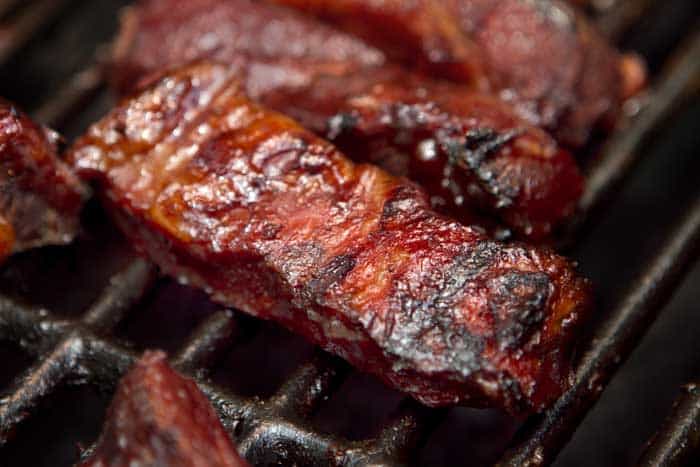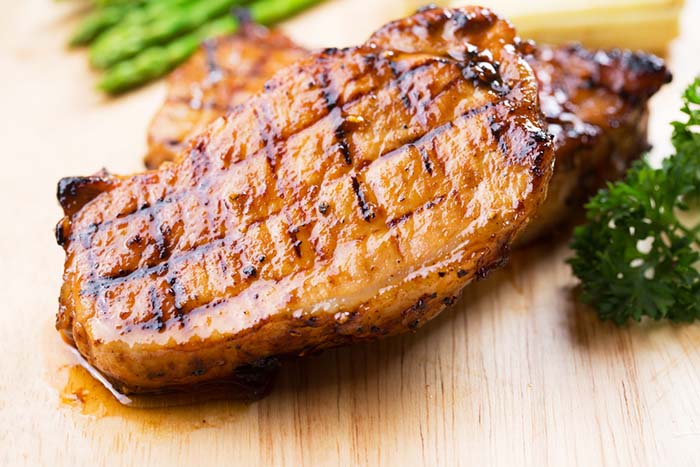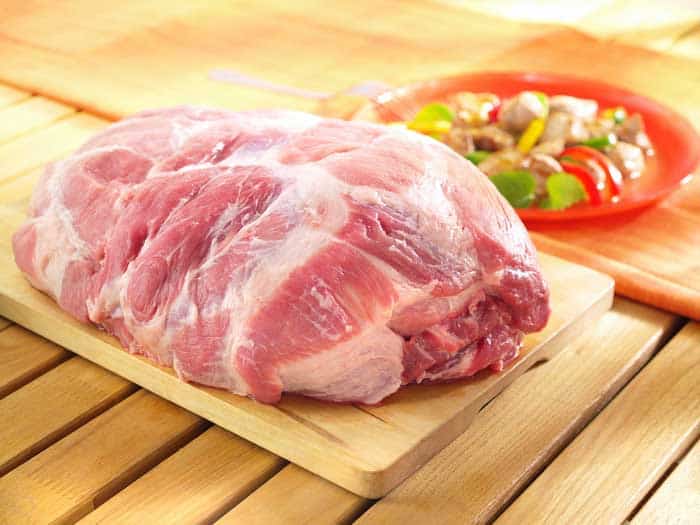Delicious smoked pork brisket cooked low and slow over applewood. This underrated pork cut is rich in flavor and perfect for slow cooking on your backyard barbecue smoker.
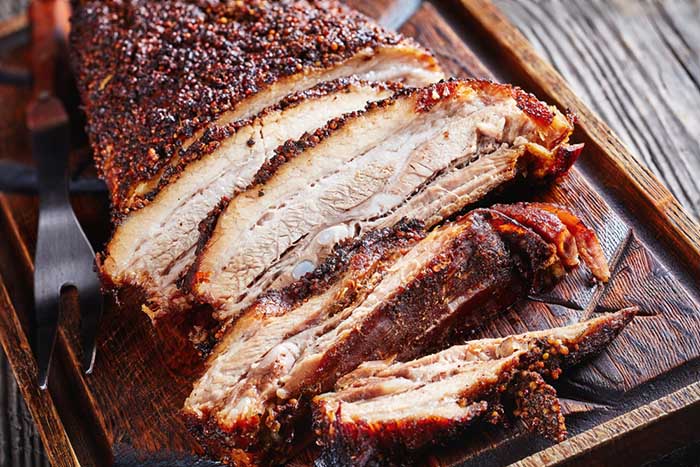
Smoked pork brisket is an unusual meat choice despite being one of the best pork cuts for barbecue smoking. Rich in fatty connective tissue and marbling, slow smoking this beautiful pork cut will bring out the best that the flavors and texture have to offer. Best of all, it’s an easy meat cut for barbecue chefs of all levels to get to grips with.
This is one of our best smoked pork recipes, and it’s easy to see why. Discover how to smoke pork brisket from scratch, from meat trimming to choosing the best dry rub seasoning. Let’s get smoking!
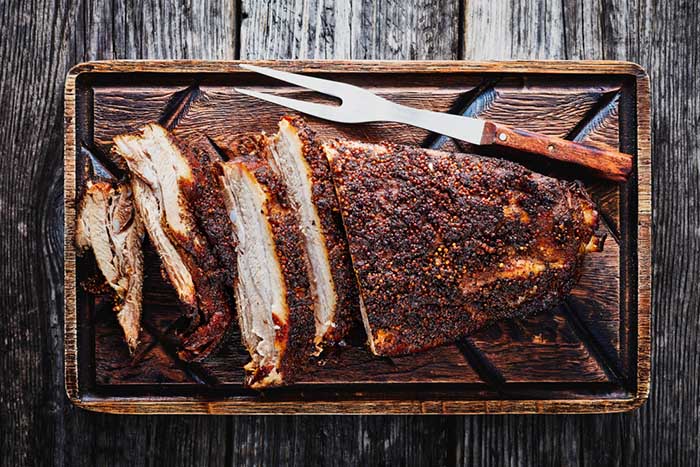
What is Pork Brisket?
Pork brisket comes from the pig’s pectoral muscle, just like how its beef counterpart is taken from the steer’s front section. This cut of meat is relatively new in mainstream markets, having roots in growing eco-conscious butchering practices.
Pork brisket is an incredible meat cut that stays moist easily during cooking thanks to its rich fat content. Because grass-fed pork is raised with an active lifestyle, premium-grade brisket will be tough and flavorful and therefore perfect for low and slow barbecue.
On average, pork brisket comes in 3.5 to 4 pounds with connective tissue, making for excellent marbling when appropriately cooked. It mixes lean and fatty cuts, making it more appealing to groups that wish for an overall flavorful experience.
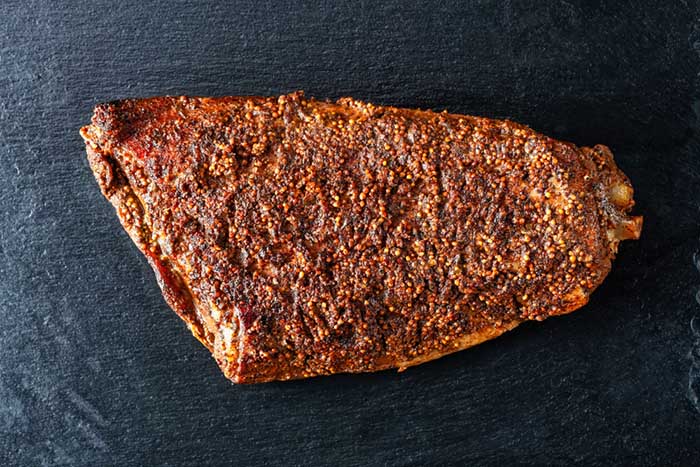
How Does Pork Brisket Differ From Other Meat Cuts?
Pork brisket is often compared to beef brisket and pork shoulder, though it offers a vastly different taste and texture.
Pork Brisket vs. Beef Brisket
Pork and beef brisket are similar cuts of meat from different animals. While pork brisket is relatively new, beef brisket has been an everyday staple for barbecues due to its large and heavy size.
- Size: The most significant difference between the pork and beef briskets is size. So, naturally, a cow will be significantly larger than a pig, making the beef brisket much larger, up to 75 or 80% larger than a pork brisket option.
- Cooking Temperature: While both of these cuts of meat require slow cooking temperatures and a longer time for a juicy result, the desired internal temperature will vary. For example, pork brisket should cook between 200°F and 225°F, while beef brisket should cook at a higher range between 225°F to 350°F.
- Cut Location: Although both cuts of meat are distinguishable to many by the brisket name, they come from slightly different areas of the animal. Pork brisket is from the pig’s underside, while beef brisket comes from the upper chest area of a cow.
- Price: The price is another significant element that separates pork brisket from its beef alternative. Often, pork brisket will be less expensive than beef briskets found in a butcher shop or grocery store shelves. This factor makes it an attractive meal choice for many individuals wanting to save money.
Pork Brisket vs. Pork Shoulder
While pork brisket cut does come from the shoulder area of the steer, there are some substantial differences between these two cuts.
- Fat Content: While the shoulder and brisket both come from the front of the pig, the fat content of each differs. Pork brisket includes more intramuscular fat, which helps create a juicy piece of meat. Conversely, pork shoulder has less fat, resulting in a chewier and tough texture.
- Cut Shape: Many butchers will cut these sections similarly. However, the pork brisket will have a cut layer of fat on top of the piece of meat, whereas the pork shoulder will usually come with bone-in for ease of cooking.
- Cooking: Typically, brisket is to be cooked slowly at a low temperature. This cooking method helps break down the fatty tissues and soften up an otherwise tough piece of meat. Pork shoulder is often for making pulled pork dishes as the meat will fall apart rather than stay together in one cut.
What to Look Out for When Buying Pork Brisket
Although pork brisket is easy to find at your local butcher or grocery, you should consider some factors when choosing the best cut for your next meal.
Alternative Names
Sometimes the pork brisket will carry the name lower picnic ham. This alternative name describes the lower portion where the brisket comes from since some butchers will reserve the term brisket for beef only.
Even Cuts
You want to look for a pork brisket with a uniformly flat throughout the cut. You want to avoid a taper cut, as this can mean some meat will not remain juicy and dry out too quickly during the cooking process. Some cuts will include the skin, which can add to the taste if you want a more flavorful piece of meat.
Meat Trimming
When you are ready to smoke your pork brisket, remove the pork brisket from the fridge and check the brisket for skin, silver skin, and outer fat.
You don’t need brisket skin, so leave a quarter-inch of fat on the outside once it’s discarded. Leaving on too much fat could make cooking longer, while no fat could cause the brisket to dry out.
Silverskin is the thin, silver-white cover over the cut. Remove by pulling the silver skin off with a knife. Likewise, remove any excess fat from the outside, leaving a quarter-inch thick layer over the brisket.
Dry Rub Seasoning
Once you’ve cleaned your cut, use a dry rub and pat it into the brisket. It should be firmly pressed into the meat with your palm to keep the seasoning on while cooking.
After application, leave your brisket out for 30 minutes to 1 hour with the rub-on. If you used a marinade, take the brisket out of the fridge and let it sit for 30 minutes to 1 hour at room temperature.
How to Smoke Pork Brisket
Once your brisket is ready for cooking, begin working on setting up your smoker. The temperature of the smoker depends on the size of your pork brisket. It’s recommended that the smoker sits somewhere between 225°F to 250°F for the best low and slow cooking process.
Once it’s begun cooking, add your wood of choice to your smoker. Depending on the type of smoker, you can skip this step if you have a wood smoker. If you have a charcoal smoker, add the wood to allow for smoking to begin.
Like with any smoking practice, your smoker should have a steady temperature and strong smoke before adding in your meat.
When adding your meat, place it directly on the grates and close. Do not open the door of your smoker again until the meat has had around 2 hours of smoking time. You want the internal temperature of the brisket to reach 190°F before serving.
If your brisket is having trouble cooking after those 2 hours, you can look to wrap it up. Using about 2 feet of butcher’s paper, set the brisket in the middle and wrap your meat like a gift.
When you’re done wrapping, place it in the smoker again and wait until the inside of the meat reaches 190°F.
Your pork brisket should be 190°F internally before it’s removed from the smoker. Let it rest for 30 minutes to 1 hour outside of the smoker.
When you are ready to carve, make quarter-inch thick cuts against the meat’s grain. Once completely carved, serve with a hearty dipping sauce or a sandwich with your choice of toppings.
Times & Temperature
Smoking pork brisket is simple when following some guidelines. Typically, it should remain in a smoker for 1.5 to 2 hours per pound of meat between 200°F and 225°F. For example, an 8-pound pork brisket will take approximately 12 to 16 hours to cook thoroughly.
The USDA recommends reaching an internal temperature of at least 145°F for pork cuts, including a three-minute resting period before serving.
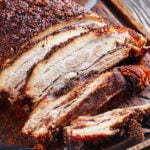
Smoked Pork Brisket
Equipment
- applewood smoking chips
Ingredients
- 2 lbs pork brisket
Dry Rub
- 2 tbsp smoked paprika
- 2 tsp cumin
- 2 tbsp chili powder
- ½ cup brown sugar
- ½ tsp dried onion powder
- 1 tsp garlic powder
- 2 tsp kosher salt
- 1 tsp ground black pepper
Instructions
- Trim skin, silverskin, and excess fat from pork brisket. Rinse under cold water and pat dry with paper towels.
- In a small bowl, combine dry rub ingredients. Use a fork to crush or remove any lumps that form.
- Apply dry rub to pork brisket, working into any folds or crevices on the meat’s surface
- Fire up your smoker to 225°F (107°C). If you’re using a charcoal grill, ensure it’s set up for 2-zone indirect cooking.
- Once smoker is at 225°F, add applewood smoking chips to the coals or wood tray. Place pork brisket fat-side up on smoker grates. Shut smoker door and leave brisket to smoke until internal temperature is 170°F (77°C), about 2 hours.
- Wrap pork brisket in foil. Place back on smoker grates and cook until internal temperature reaches 190°F (88°C), about 30-60 minutes.
- Remove pork brisket from the smoker. Tent in fresh foil and leave to rest for 30 minutes.
- Serve by carving into quarter-inch thick slices. Ensure you slice against the grain to retain texture and flavor.
